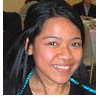Maria Vivien Visaya: Difference between revisions
From Santa Fe Institute Events Wiki
No edit summary |
No edit summary |
||
| (One intermediate revision by the same user not shown) | |||
| Line 1: | Line 1: | ||
[[Image:vivien.jpg|left]] | [[Image:vivien.jpg|left]] I'm a Ph.D. student in Mathematics (Dynamical Systems) at Kyoto University. I did my undegraduate in Mathematics and Masters in Applied Mathematics at the University of the Philippines-Diliman. | ||
Under the supervision of Prof. Hiroshi Kokubu, my thesis topic is on finding a lower bound for the topological entropy of multivalued maps coming from a time series of an unknown dynamical system. Understanding time series is crucial if we want to know something about how the true but unknown underlying system that drives it behaves. The | Under the supervision of Prof. Hiroshi Kokubu, my thesis topic is on finding a lower bound for the topological entropy of multivalued maps coming from a time series of an unknown dynamical system. Understanding time series is crucial if we want to know something about how the true but unknown underlying system that drives it behaves. The | ||
method of estimation is by means of a multivalued map obtained from a time series and showing a horseshoe-like dynamics present in this map. The notion of symbolic dynamics and phase-space reconstruction play crucial roles as well. | method of estimation is by means of a multivalued map obtained from a time series and showing a horseshoe-like dynamics present in this map. The notion of symbolic dynamics and phase-space reconstruction play crucial roles as well. | ||
Just very recently, I've been interested in studying coupled cell networks (mainly focusing on the works of Martin Golubitsky). Given a system of ODEs, by restricting to the polydiagonal subspace, can we say something about the network architecture of the original system? What relation exists among the network symmetry group (which deals with the global stucture), the network symmetry groupoid (local structure), and the original network? Which aspects of coupled cell dynamics are due to network architecture? How can patterns of synchrony for a given network be established in practice? | Just very recently, I've been interested in studying coupled cell networks (mainly focusing on the works of Martin Golubitsky). Given a system of ODEs, by restricting to the polydiagonal subspace, can we say something about the network architecture of the original system? What relation exists among the network symmetry group (which deals with the global stucture), the network symmetry groupoid (local structure), and the original network? Which aspects of coupled cell dynamics are due to network architecture? How can patterns of synchrony for a given network be established in practice? I'm looking forward to discussions with everyone specialising in the application of mathematics in different fields (Physics, Economics, Systems Biology (modeling of biological systems such as coupled oscillators and circadian rhythm in particular), etc) so see you all in June. | ||
Latest revision as of 16:06, 28 June 2006

I'm a Ph.D. student in Mathematics (Dynamical Systems) at Kyoto University. I did my undegraduate in Mathematics and Masters in Applied Mathematics at the University of the Philippines-Diliman.
Under the supervision of Prof. Hiroshi Kokubu, my thesis topic is on finding a lower bound for the topological entropy of multivalued maps coming from a time series of an unknown dynamical system. Understanding time series is crucial if we want to know something about how the true but unknown underlying system that drives it behaves. The method of estimation is by means of a multivalued map obtained from a time series and showing a horseshoe-like dynamics present in this map. The notion of symbolic dynamics and phase-space reconstruction play crucial roles as well.
Just very recently, I've been interested in studying coupled cell networks (mainly focusing on the works of Martin Golubitsky). Given a system of ODEs, by restricting to the polydiagonal subspace, can we say something about the network architecture of the original system? What relation exists among the network symmetry group (which deals with the global stucture), the network symmetry groupoid (local structure), and the original network? Which aspects of coupled cell dynamics are due to network architecture? How can patterns of synchrony for a given network be established in practice? I'm looking forward to discussions with everyone specialising in the application of mathematics in different fields (Physics, Economics, Systems Biology (modeling of biological systems such as coupled oscillators and circadian rhythm in particular), etc) so see you all in June.
